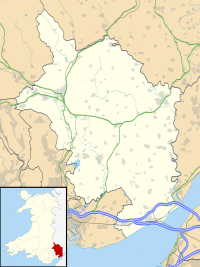St Cadoc's Church, Llangattock-juxta-Usk
| St Cadoc's Church, Llangattock-Juxta-Usk, Monmouthshire | |
|---|---|
| Church of St Cadoc | |
 The nave and tower | |
| 51°46′53″N 2°58′20″W / 51.7815°N 2.9721°W | |
| Location | Llangattock-Juxta-Usk, Monmouthshire |
| Country | Wales |
| Denomination | Church in Wales |
| History | |
| Status | Parish church |
| Founded | C15th century |
| Architecture | |
| Functional status | Active |
| Heritage designation | Grade II* |
| Designated | 9 January 1956 |
| Architectural type | Perpendicular |
| Administration | |
| Diocese | Monmouth |
| Archdeaconry | Monmouth |
| Deanery | Abergavenny |
| Parish | Llangattock-Juxta-Usk |
| Clergy | |
| Vicar(s) | The Reverend J Humphries |
The Church of St Cadoc, Llangattock-Juxta-Usk, Monmouthshire is a parish church with its datable origins in the 15th century. The church was restored in 1827 and again in 1864–5. It is a Grade II* listed building.
History
[edit]The church sits just south of the River Usk, next to the small hamlet of The Bryn.[1] There is nothing datable before the 15th century, although its origins are earlier.[2] The building was reconstructed in 1827 by the Gloucestershire engineer John Upton and restored in the mid-19th century by John Prichard.[3] It has been little altered since that time [1] and remains an active parish church.[2]
Architecture and description
[edit]The church is constructed of Old Red Sandstone.[3] The style is Perpendicular.[1] The interior of the church is "very plain"[1] but contains a surprising collection of medieval wall tiles, one dated to 1456,[1] which are similar to those found in the, more significant, priory churches of St Mary's Priory Church, Monmouth, Tintern Abbey and the Church of St David, Llanthony.[3] The architectural historian John Newman noted that their presence in "this modest parish church has not been explained".[3] The church is a Grade II* listed building.[1]
Notes
[edit]References
[edit]- Newman, John (2000). Gwent/Monmouthshire. The Buildings of Wales. London: Penguin. ISBN 0-14-071053-1.

